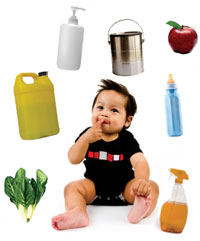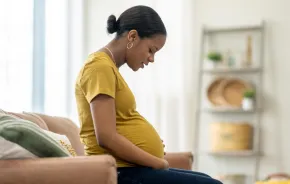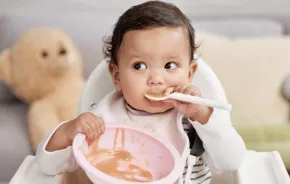 Scary news reports about lead and phthalates lurking in baby products may have you wondering what to avoid or ban altogether from the nursery. Since babies and toddlers eat, drink and breathe more per pound of body weight than adults — and have developing brains and organs — they are especially susceptible to potentially harmful chemicals. Here’s a basic list of toxins to keep away from your tot.
Scary news reports about lead and phthalates lurking in baby products may have you wondering what to avoid or ban altogether from the nursery. Since babies and toddlers eat, drink and breathe more per pound of body weight than adults — and have developing brains and organs — they are especially susceptible to potentially harmful chemicals. Here’s a basic list of toxins to keep away from your tot.
Baby skin care
Skin is a major exposure route to toxins, and that’s especially true for babies. It’s best to avoid potions with fragrances (“parfum”), parabens, petrolatum, mineral oil, quarternium compounds, sodium lauryl sulfate or sodium laureth sulfate, PEG (polyethelyne glycol), boric acid or sodium borate (in diaper creams), non-organic lanolin, aluminum, or ultrafine (nano) particles.
Antibacterials, especially triclosan and triclocarban, are under scrutiny for several reasons, among them the potential to prohibit immune development. A comprehensive University of Michigan study concluded that plain soap is just as effective.
For sun protection, use brimmed hats, clothing and umbrellas as much as possible. The American Academy of Pediatrics recommends the spare application of sunscreen, if any, for babies younger than 6 months; and only as a last resort. It is also highly recommended to consult a doctor before applying any sunscreen on your infant's skin. The Environmental Working Group (EWG), a research organization focusing on chemicals, evaluated toxicity and performance of 1,070 sunscreens. “Physical blocks, meaning those containing titanium or zinc as the active ingredient, are preferred over those containing oxybenzone, homosalate and other active ingredients,” says the EWG’s Jovana Ruzicic. Always test a new sunscreen on a tiny patch of baby skin to check for reactions.
Organic baby foods
Whenever it’s affordable, buy organic baby food or juice when the tot menu includes any of EWG’s “dirty dozen” produce items: spinach, apples, kale, celery, cherries, imported grapes, domestic blueberries, peaches, nectarines, potatoes, strawberries and bell peppers. These are singled out because of the nature and amount of pesticides used to grow them.
Steer clear of meat and dairy products with residual hormones and antibiotics. Shun synthetic sweeteners, dyes and preservatives.
Baby cleaning supplies
Buy baby detergents free of fragrances, dyes or petroleum-based ingredients. Avoid aerosols, air fresheners and very fragrant cleaners, and minimize the use of cleaners labeled “caution,” “warning” and especially “danger.”
The appealing terms “green,” “natural,” “non-toxic” and “biodegradable” are not legally defined and can mean very different things in different products. For example, the cleaner Simple Green sounds green and is labeled “non-toxic.” But it contains butyl-cellosolve (also found in Windex, Formula 409 and other cleaners), a respiratory irritant, potential kidney and liver toxin, and an ingredient shunned by the Women’s Voices for the Earth Household Hazards report.
Plastics and your baby
Plastics have earned a bad rap — especially polyvinyl chloride (PVC) and bisphenol-A (BPA). Pass on PVC products (e.g., plastic bibs, vinyl food or bottle coolers, shower curtains, PVC baby mattresses, pliable toys, and some plastic wraps), which may contain phthalates and oftentimes lead or other undesirable metals used as stabilizers.
Most likely you’ve heard that you should be using BPA-free bottles and sippy cups. But BPA also lines most aluminum and tin cans (including those containing premixed formulas) and can transfer to the cans’ contents. Buy fresh, frozen, jarred or powder formula.
Do not microwave plastics of any kind. Use glass for food storage rather than plastic wrap or containers. Visit Safe Start and the Smart Plastics Guide (see sidebar below) for alternatives.
Lead exposure
“Exposure to lead at any level is hazardous for infants and children,” says Dr. Steve Gilbert, University of Washington toxicologist and advocate for blood lead level testing for children. Lead may be released from plastic and painted products, especially those made in China. A major exposure worry for little ones is soil and disturbed paint in and around residences painted before 1978, when lead was banned from paint. Where there’s chipping or crumbling paint in homes or on cribs or toys, or remodeling or bare soil around older homes, sample and test to determine if lead is present.
Household dust
Dust contains a potpourri of “fine” chemicals, potentially including fire retardants, pesticides, phthalates, mites, formaldehyde, lead and others. Take shoes off indoors to minimize tracking in pesticides and chemicals.
It’s a lot to ask of busy parents, but dust frequently and keep floors as clean as possible. Damp-wipe electronics frequently, since fire retardants collect in TV and computer dust. For carpets, use a power-brush and high-efficiency vacuum filter. For non-carpeted floors, a quick mopping (a small towel dampened with water and white vinegar, wrapped around broom bristles) is a time saver between more thorough mopping.
Other common hazards
Keep magnets way out of reach. Mount a carbon monoxide detector — or use a plug-in model — just outside baby’s room. If you’re breastfeeding, keep your milk healthy by avoiding mercury-laden seafood or farmed fish; don’t overheat non-stick coated pans; avoid direct use of pesticides and fertilizers in your yard; and check out your personal care products at cosmeticsdatabase.org.
Michelle Gaither is an environmental scientist, chemical-wary mother of four and founder of ToxInspect, offering a service to identify toxins in homes.
Signal words on packaging
Most cleaners do not have a list of ingredients on their containers, leaving us blissfully unaware of the contents. “Signal words” are defined by the amount of the product that “may be fatal or harmful if swallowed, inhaled or absorbed through the skin by an adult 180-pound man (not an 8- to 25-pound baby!).”
Caution: an ounce to a pint
Warning: a teaspoon to an ounce
Danger: a taste to a teaspoon
Great websites with information on toxins
Safe Start for Kids
EWG's cosmetics database: Baby care
Women's Voices for the Earth: Household hazards
Smart plastics guide: Healthier food uses of plastics
Healthy Child Healthy World
Reducing exposure to lead in older homes
EWG's downloadable "Dirty Dozen"list for fruits and vegetables









